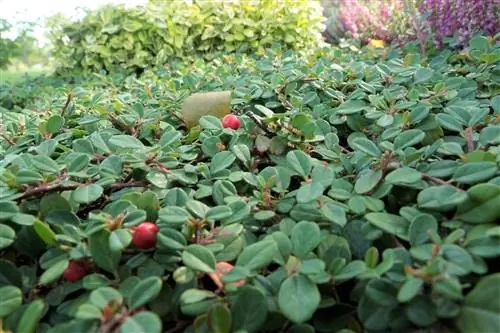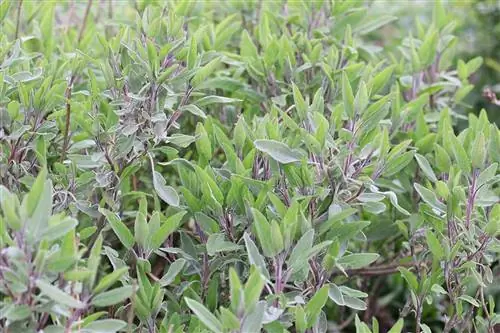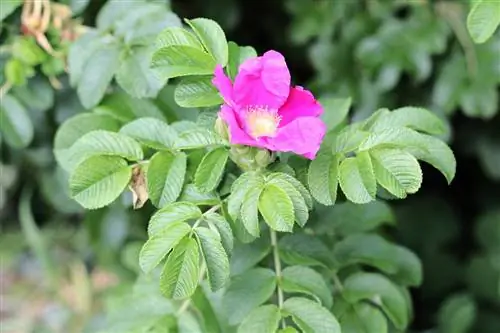- Author admin [email protected].
- Public 2023-12-17 03:39.
- Last modified 2025-06-01 06:48.
The cotoneaster can be present in the garden as a magnificent dark green carpet or as a bushy shrub with attractive red fruits. The fact is that this plant impresses with its powerful colors, which in some species decorate the garden all year round. Botanically, the plant belongs to the rose family and is overall robust and undemanding in terms of care and location - making it a perfect plant for beginners.
The extensive genus Cotoneaster, in German cotoneaster, combines evergreen and deciduous shrubs as well as a number of small trees with very different shapes. Prostrate and creeping forms occur as well as bushy and hemispherical varieties or those with overhanging branches. All species produce small pink or white flowers. However, they owe their popularity primarily to their striking red, berry-like apple fruits and their colorful autumn leaves. Because of their multifaceted growth habit, they are very versatile in the garden.
Profile
- Height 0.1 - 4.5m
- Bloom from late spring to midsummer
- Normal garden soil
- Sunny location
- Hardy, partly evergreen, partly deciduous
Location
Overall, the cotoneaster is one of the more robust and resilient plants. That's why it also accepts unfavorable locations. However, if a new location is sought for this plant, then it should be sunny, because this is where the cotoneaster feels most comfortable and thanks this location with lots of fruits and flowers.
The plant also feels comfortable in light partial shade and blooms intensively there. The creeping variety is often found in nature on embankments on the tops of walls or under light trees. In the garden, the cotoneaster also appreciates its location in the rock garden - for example together with the summer phlox and the stonecrop.
The plant does not have high demands on its soil. The cotoneaster thrives particularly well on a water-permeable, moisturizing and nutrient-rich substrate that is humus and loose in texture.
For planting, you can either use normal garden soil or garden soil mixed with sand to loosen it up.
- robust in terms of location
- particularly intense flowering in sunny locations
- normal potting soil or potting soil mixed with sand is sufficient as a substrate
Repotting
The cotoneaster in the flowerpot should be repotted every two years. Ideally, this repotting should take place at the beginning of spring, because then enormous root growth occurs, for which the plant needs sufficient space.
During repotting, the roots should be trimmed straight away, as this allows for better branching of the root system and thus better supply to the plant.
Repotting into a larger planter is urgently required when the plant pushes out of the planter due to its enormous root formation.
Tip:
The cotoneaster finds repotting particularly pleasant when a third of the old soil is mixed with new substrate and the plant is reinserted into this mixture.
Wintering
The plant is generally hardy and can therefore easily overwinter as a bedding plant with appropriate frost-protecting cover. If the plant is potted, overwintering temperatures between 0 °C and 10 °C are optimal. Potted plants in the greenhouse have perfect wintering conditions. If the potted cotoneaster is to overwinter outside, it makes sense to place the planting bowl in warm peat and cover the entire surface of the pot with a layer of substrate about five centimeters thick. So that the cotoneaster in the pot does not dry out in winter, it should be covered with a plastic film, which also offers protection from frost.
Pouring
The cotoneaster is very undemanding - even when it comes to irrigation. During the growth phase, however, there should be a regular supply of water in order to optimize growth and flowering. It is important that the plant is only watered when the substrate has already dried slightly. However, occasional complete drying out of the root ball is not a problem for the plant if this does not become a permanent condition.
The cotoneaster reacts much more sensitively to excessive watering and waterlogging than to drought. In this case, the root balls can rot and ultimately the roots can rot completely. This also applies to the winter months, when the cotoneaster should only be watered sporadically.
Tip:
Occasional drying out promotes root growth and is even good for the plant.
Fertilize
The cotoneaster is also very undemanding when it comes to fertilization. From April to September, the plant should be fertilized once a month with a commercially available liquid fertilizer or with sticks or granules. It is very good to mulch the plant extensively with grass clippings in spring and autumn leaves in autumn, as this can prevent the plant from drying out too much.
- Fertilization with commercial liquid fertilizer once a month or with sticks
- Mulching with lawn clippings in spring, highly recommended with leaves in autumn
Cutting
As a care measure, regular pruning can be very good and the cotoneaster ground cover variety in particular tolerates radical pruning very well. A cut in height and width is recommended, because older plants in particular tend to branch sideways and sprout particularly intensively here.
The time of cutting depends on the species. Deciduous species of cotoneaster should be pruned in winter, while evergreen plants should be pruned in spring, because then the formation of flowers and fruits will be more optimal later. For a hedge-like species, pruning should again take place in August.
Pruning all flowering species works best when the scissors are placed directly above the bud that faces outwards. The scissors should be held at an angle to the branch. The cutting notch and the bud should be half a centimeter to one centimeter apart. It is important to remove dead branches. Shoots that are close to each other or that cross each other should also be removed.
Propagation
The propagation of cotoneaster can take place by sowing ripe berries, propagation by sinkers, by cuttings taken in late autumn or by cuttings from half-mature shoots in deciduous species or mature shoots in evergreen plants. In any case, it is easier to buy young plants commercially, whereby the young plants are immersed in thick mud for half an hour before being planted, then placed in soil and covered with a plastic cover to optimize root formation.
- Propagation takes time and effort
- Planting young plants from the market is easier
Pests and diseases
Occasionally the plant is attacked by aphids, sooty mold or fungi. Then only treatment with chemical pesticides helps if the infestation is moderate. If the infestation is severe, the plant should be removed to avoid attacking plants that are still he althy. However, with appropriate care, pest infestations are very rare.
Popular species
The cotoneaster Cotoneaster congestus is an evergreen dwarf shrub about 0.2m high. It bears tiny light green leaves and small pink flowers in early summer. Red berries appear in autumn.
Cotoneaster conspicuus, also evergreen, forms a dense network of overhanging branches. It grows up to 2m high. The small, shiny dark green leaves almost completely disappear beneath the white flowers. In autumn, bright red apple fruits take their place. The Decorus variety is well suited for rock gardens with its mat-shaped growth; it only grows to around 0.5 - 0.9m high.
Cotoneaster dammeri is an evergreen espalier shrub that only grows to 0.1m high but can reach a width of 2.1m. It has small, glossy dark green leaves, white flowers and red apple fruits. The species is an ideal ground cover for embankments.
Cotoneaster microphyllus, an evergreen cotoneaster about 0.2m high, can grow 2.4m wide. It has shiny dark green leaves on the top and gray hairy leaves on the bottom. White flowers appear in late spring and early summer, and countless scarlet berries appear in autumn.
Frequently asked questions
How much does it cost to plant the cotoneaster in the garden?
The plants are relatively cheap, with unit prices ranging between around 1.20 euros and 2.50 euros, especially since they grow a lot and can therefore, for example, be used to equip a small rock garden with just a few plants.
Is cotoneaster suitable for the garden when there are children?
Prunasin is contained in both the flowers and leaves as well as in the bark of cotoneasters. Eating 10 to 20 fruits can cause vomiting diarrhea and nausea, as well as swelling of the lips and a burning sensation in the mouth. Therefore, this plant should only be used in garden areas that are inaccessible to children and pets.






